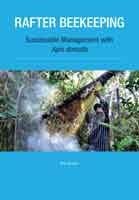Eric Guerin is a French biologist specialized in Asian native honey bee conservation and sustainable beekeeping. Based in Southeast Asia since 2008, he has made a special effort to document the work of honey hunters and rafter beekeeping communities, diffusing sustainable honey collection practices, introducing small-scale beekeeping as part of organic agriculture development, raising awareness on native honey bee conservation, and supporting optimization of forest honey value chains.
The giant honey bee, Apis dorsata F., is a single-comb, open-nesting species of honey bee. Its distribution area covers much of southern Asia, including parts of Pakistan and all the way to the eastern part of the Indonesian chain of islands. Attempts to induce Apis dorsata to remain in a hive have failed (Koeniger N, Koeniger G, Tingek, 2010; Crane, 1999; Thakar, 1973), however, in several locations of Southeast Asia, locals have used tree-poles, or rafters, positioned at a slight angle and low to the ground, that mimic tree branches, in order to attract migrating swarms of Apis dorsata (Petersen, 2012; https://www.beesunlimited.com). This traditional practice, first reported in 1902 by Fougères (Crane, Luyen, Mulder, & Ta, 1993), and commonly referred to as “Rafter Beekeeping,” allow beekeepers to harvest honey two or three times from the same colony per season without harming the bees (Tan et. al., 1997).
Intended to serve as a training manual this book has been developed on the basis of related literature as well as personal observations by the author. It aims to provide the essential requirements for the implementation of rafter beekeeping and presents guidelines for rafter construction and management as a means of sustainable harvesting. Nevertheless, it should not be considered as a substitute for practical training by an experienced rafter beekeeper, at least in the first stages of implementation. As is the case for any beekeeping activity, experience is a key factor of success.



